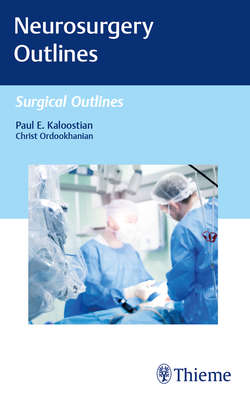Читать книгу Neurosurgery Outlines - Paul E. Kaloostian - Страница 75
На сайте Литреса книга снята с продажи.
Treatment Options
Оглавление• Acute pain control with medications and pain management
• Physical therapy and rehabilitation
• If symptomatic with cord compression:
– Urgent surgical decompression and fusion over implicated segments if deemed suitable candidate for surgery
• If poor surgical candidate with poor life expectancy, medical management recommended
– Surgery may be done anteriorly, posteriorly, or combined two-stage approach for added stabilization
– May include a combination of the following techniques: Laminectomy (entire lamina, thickened ligaments, and part of enlarged facet joints removed to relieve pressure), Laminotomy (section of lamina and ligament removed), Foraminotomy (expanding space of neural foramen by removing soft tissues, small disk fragments, and bony spurs in the locus), Laminoplasty (expanding space within spinal canal by repositioning lamina), Diskectomy (removal of section of herniated disk), Corpectomy (removal of vertebral body and disks), Bony Spur Removal
• Corpectomy approaches:
– Anterior (Thoracoscopic): Pleural entry to access anterior thoracic; broadest canal decompression, satisfactory visualization of thecal sac; easy graft insertion; anterolateral screw-plate fixation (see ▶Fig. 2.4 and ▶Fig. 2.5)
– Anterolateral (Retropleural): Most direct anterior approach requiring retropleural dissection; canal decompression; anterolateral screw-plate fixation
– Posterolateral (Lateral Extracavitary): Satisfactory visualization of thecal sac; anterior stabilization; posterior tension band preservation; unilateral decompression (see ▶Fig. 2.6)
– Posterior (Transpedicular): Circumferential decompression; difficult graft insertion; unideal thecal sac positioning (see ▶Fig. 2.7)
Fig. 2.4 (a–c) Posterolateral approach to performing a cervicothoracic corpectomy. Illustration demonstrates operative view. Intraoperative image demonstrates exposure for multilevel thoracic corpectomy, and postoperative CT scan demonstrates successful corpectomy from a unilateral approach. (Source: Cervicothoracic corpectomy. In: Fessler R, Sekhar L, eds. Atlas of Neurosurgical Techniques: Spine and Peripheral Nerves. 2nd ed. Thieme; 2016).
Fig. 2.5 (a, b) Illustration demonstrates trajectory of thoracic corpectomy, from a posterior approach, as well as the area of bone removal (colored). Postoperative CT scan demonstrates successful thoracic corpectomy. (Source: Procedure. In: Kim D, Choi G, Lee S, et al, eds. Endoscopic Spine Surgery. 2nd ed. Thieme; 2018).
Fig. 2.6 (a–d) Preoperative MRI reveal thoracic disk herniation (T7–T8) in a patient who received lateral, retropleural partial corpectomy. Postoperative MRI reveal residual intradural disk (free-floating calcified portion) and cord decompression. (Source: Surgical management. In: Baaj A, Kakaria U, Kim H, eds. Surgery of the Thoracic Spine: Principles and Techniques. 1st ed. Thieme; 2019).
